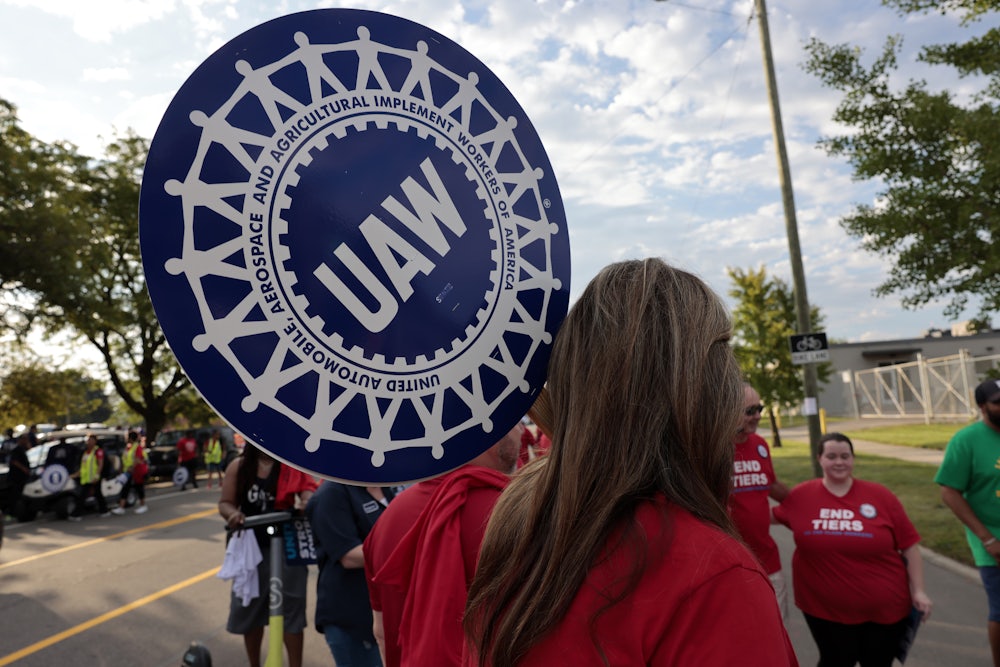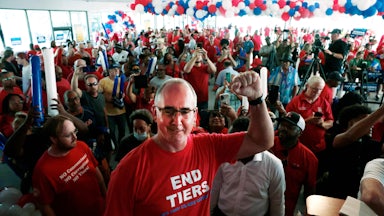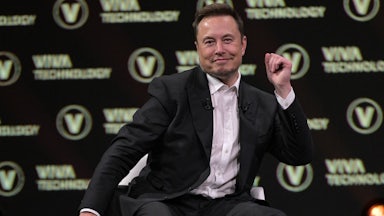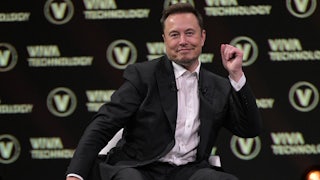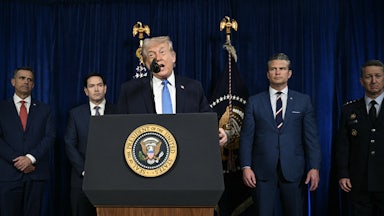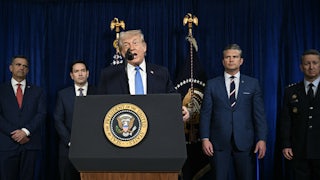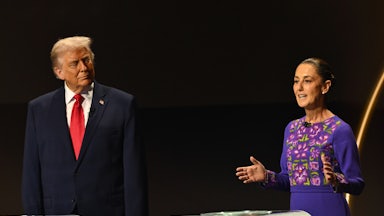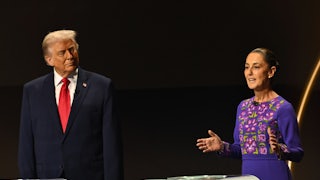If the Inflation Reduction Act can be said to have a mascot, it’s the electric vehicle. Whenever they’re not out taking E.V. joyrides, White House officials tout a surge of manufacturing spending since that bill’s passage last summer. The Department of Energy now tallies $140 billion worth of announced investments in E.V.s since President Joe Biden took office, including over 100 new or expanded E.V. components or assembly plants. That push, however, has invited the ire of an unusual foe: the United Auto Workers, whose members are now on the brink of what could be the second-largest work stoppage in 25 years.
The new leadership of the muscular union has taken a more combative tone with both automakers and Democrats than its predecessors, withholding its traditional early-days endorsement of the party’s White House incumbent. Amid tense negotiations over the contract that covers its 146,000 members employed by the Big Three (Ford, GM, and Stellantis—the owner of Chrysler and Jeep), the UAW is sounding the alarm that the government-subsidized push for electrification is being used to undermine the kinds of wages and working conditions for which its members have long fought.
“Not only is the federal government not using its power to turn the tide,” UAW President Shawn Fain has said, “they’re actively funding the race to the bottom with billions in public money.” A strike could now start in the early hours of the morning after the union’s contract expires Thursday at 11:59 p.m.—despite Biden’s public assurances that it won’t happen. Among the biggest sticking points are demands for higher wages, a restoration of previously axed benefits, more time off, and increased profit sharing. For the first time in UAW history, there’s also a possibility that such a work stoppage could target the entire Big Three; traditionally, strikes have hit companies one by one to force a deal.
The stakes are high for automakers still figuring out how to make money off electrification. The Big Three are enjoying a record boom, having raked in a combined $21 billion in total profits during the first half of this year alone. Altogether, their CEOs took home $74 million last year. But thin margins on E.V.s are making them sweat. In July, Ford announced that it expects its E.V. unit to lose $4.5 billion this year, revised upward from a previous estimate of $3 billion. On a quarterly earnings call, one investor analyst calculated that Ford was losing $32,000 on each E.V. sold through Ford Pro, the company’s otherwise profitable arm dealing with commercial customers. GM currently projects its E.V. business won’t be profitable until 2025.
E.V. costs for manufacturers are declining and could tumble further still thanks to federal incentives. Bearish Wells Fargo analyst Colin Langan found that E.V.s now cost roughly $7,000 more to make than an equivalent internal combustion engine vehicle, which is down from the $10,000 premium he enumerated last year. Many of those costs, though—including those for the minerals required to make batteries such as cobalt and lithium—are outside the direct control of carmakers. A far easier place for them to cut costs en route to electrification is in the workforce.
Their hottest competition, after all, is Tesla. While the proudly anti-union company’s market share has begun to decline, Teslas still account for about 60 percent of all E.V.s sold in the United States and stand poised to dominate the country’s E.V. charging network. Big Three automakers currently pay an estimated average of $66 per employee per hour, including wages and benefits. If the union’s demands for a 40 percent pay increase are met, that figure could grow to $136 per hour, The Wall Street Journal reported; over the weekend, Bloomberg reported that UAW negotiators would accept a slightly lower increase, though still one greater than the 9 to 15 percent offers automakers have made public thus far. Tesla is estimated to pay just $45.
To grind out profits from E.V.s, carmakers have pursued some familiar strategies. Many are relocating electric car production either abroad or in less union-friendly states. A proposed bonus to IRA tax credits for consumers who bought union-made E.V.s was nixed during negotiations last summer by West Virginia Senator Joe Manchin, who feared the provision would drive investments away from nonunion firms in his home state.
That’s contributed to the concentration of new E.V. investments in Republican-controlled right-to-work states—including the emerging “battery belt” from North Carolina to Alabama. Foreign automakers have long flocked to the South in search of lower wages and anti-union laws. Across the board, car companies see the region as a good place to go electric. A recent study by Brookings Metro has found that two-fifths of public dollars flowing from the IRA, CHIPS, Science Act, and Bipartisan Infrastructure Law are going to the South. Sixty-two percent of that investment is in either electric vehicle and battery manufacturing or clean energy technologies.
Earlier this summer, Fain spoke out against a $9.2 billion Department of Energy loan to help Ford and South Korean battery maker SK On finance three battery plants in Tennessee and Kentucky, calling it a “giveaway” furnished with “no consideration for wages, working conditions, union rights or retirement security.”
Among the union’s other concerns are that such joint ventures—including Stellantis’s deal with Samsung SDI—are being used to undermine industry standards and parcel workers off from one another. As it happens, producing the batteries used to power E.V.s involves techniques that are relatively novel to U.S. factories. Much of the expertise for their manufacture comes from outside the U.S., so automakers have teamed up with foreign firms. Among those is the Ultium Cells plant in Ohio, a partnership between GM and the South Korean company LG Energy Solutions. Many current Ultium employees worked at GM’s nearby Lordstown plant, which the company shuttered in 2018. Jobs under the new arrangement, however, are a far cry from the ones those workers once held: Where wages at GM Lordstown started at $32 per hour, until recently, workers starting out at Ultium made just $16.50. After seven years, production workers could make $20 per hour.
Such ostensibly green jobs can also be treacherous ones. So far this year, Ultium’s Ohio facility has been the subject of six Occupational Safety and Health Administration complaints. Workers report being sprayed in the face with toxic chemicals and having their work areas fill up with smoke. In late June, a defective battery caught fire and two employees were sent to the hospital for smoke inhalation. Six Ultium workers were suspended for months after walking off the job in protest of the plant’s lack of OSHA-mandated safety showers, Labor Notes’ Keith Brenner Brown reported. That the Big Three are chasing Tesla-style margins on their cars also raises fears that they’ll warm to Tesla-style workplace safety norms. A Forbes investigation found that Tesla’s Fremont, California, factory amassed 54 violations from state OSHA inspectors between 2014 and 2018. The plant’s violations and fines over that period surpassed those of 10 other major U.S. plants combined, including ones owned by Ford and GM.
The Ultium facility is part-owned by GM. Still, workers there who voted overwhelmingly last year to unionize with the UAW (710–16) aren’t included in the Big Three contract being bargained over now. GM maintains that Ultium is a wholly separate facility, and—as such—that UAW workers needed to start from scratch to organize the facility and negotiate a separate collective bargaining agreement. Months into those talks, Ultium workers last month won a 25 percent pay increase at the bargaining table.
As factories retool to make electric vehicles, some changes seem obvious. When GM’s Detroit-Hamtramck “Factory Zero” plant was reopened after a year and a half to make only electric vehicles, including the electric Hummer, lines devoted to assembling internal combustion engine vehicles had been eliminated. Other changes seem designed to pay workers less for the same job, spinning parts of the E.V. production process out of the master agreement. Battery assembly work at Factory Zero is now done in a separate part of the plant by employees of a wholly owned GM subsidiary called GM Subsystems; GM workers who did that work previously were ineligible for those jobs, and workers covered by the master agreement can’t transfer over to battery assembly, where work is governed by a different collective bargaining agreement. Where the Big Three master agreement has entitled the latter to an extra $1 in profit-sharing for every $1 million the company makes, GM Subsystems employees get just 25 cents.
They also enjoy fewer protections on the job. “Until recently they’ve had to make do with one steward for their whole unit—a steward with only 30 hours a week to educate and defend their bargaining unit, the remainder of the time working a job,” Chris Viola, a GM employee at Factory Zero, wrote recently. “By comparison, the General Motors workers in the rest of the plant have a minimum of two full-time stewards.” In what’s almost certainly a nod toward UAW complaints, the White House announced at the end of August that it was making $15.5 billion in loans and grants available for companies to retool factories and retrain workers, with a preference for projects “likely to retain collective bargaining agreements and/or those that have an existing high-quality, high-wage hourly production workforce.”
Media coverage of contract negotiations has raised fears that a strike, or even just a strong contract, could threaten Big Three electrification efforts and raise the price of cars across the board. The companies themselves, though, have been clear with investors that their goal isn’t to make cleaner cars more affordable but to make money for shareholders, who’ve been on the receiving end of generous payouts in recent years via dividends and share buybacks. “Ford strategy is not to build [IRA] compliant vehicles that are very affordable for acquisition cost but lose lots of money,” President and CEO Jim Farley said on the company’s quarterly earnings call in July. “Our strategy is to make 8 percent margin irregardless of the price point, and we’re going to allocate capital along those lines.”
More right-wing outlets writing on strike prospects have been eagerly stoking a jobs-versus-environment framing that pits workers’ demands against climate goals. “If the Biden White House is forced to choose between the demands of autoworkers and the highly subsidized greening of the American economy, it will choose the latter,“ Noah Rothman wrote last week in the National Review. A letter to Big Three CEOs circulated by the Labor Network for Sustainability, meanwhile—signed by the country’s biggest green groups—calls on the companies to meet the union’s demands. “We, and millions of Americans,” the letter states, “want what UAW is bargaining for: family-sustaining, community-supporting, union jobs in a green energy economy; one that allows us all to make a living on a living planet.”
